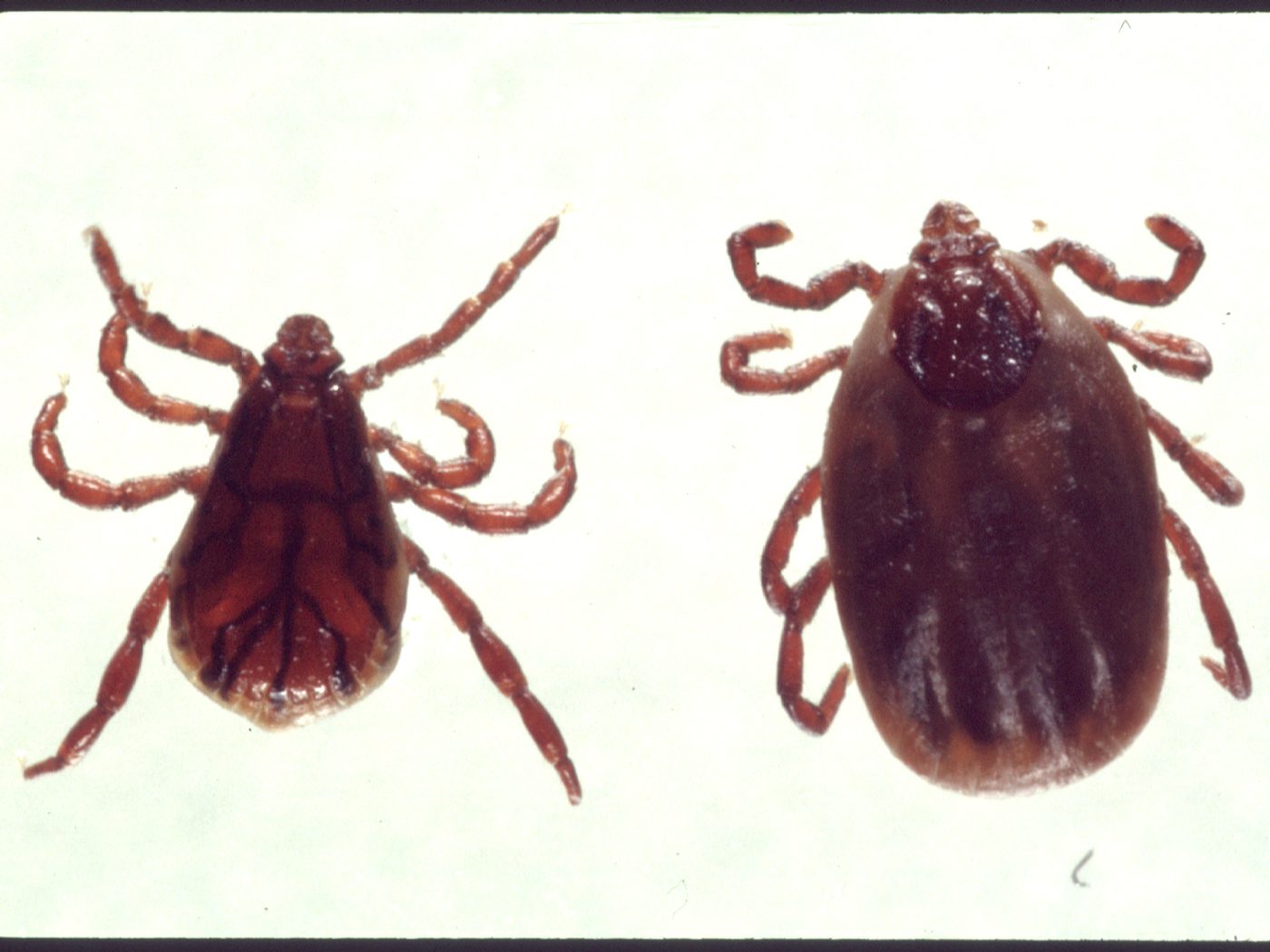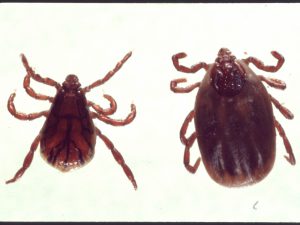
by Laurie Osgood | Jul 11, 2018

Check for ticks after being outside.
Photo source: http://photos.ifas.ufl.edu
Does the mere thought of ticks make you feel itchy all over? Ticks are not a fun thing to talk about, but we can’t ignore them. Ticks can pose a real threat to your outdoor summer fun. Here in the Florida Panhandle, you can find ticks all year-long. But ticks are the most active in warm weather, from April through September.
There are many varieties of ticks in the world, but only a few spread disease to people. Of the ticks that can be found in North Florida, the black-legged tick, also known as the deer tick, is the most dangerous because it is the primary vector of Lyme disease in humans. Learn more about the black-legged tick.
Symptoms of a Tick Bite
According to the UF/IFAS Extension’s Department of Entomology and Nematology guidebook, Pests In and Around the Southern Home, the most common symptoms associated with tick bites are rash, fever, chills, aches, and pains. If you have been bitten by a tick that carries Lyme disease, a bullseye-shaped rash may appear within 3-30 days. This circular rash usually appears before you experience fever or any other symptoms.
Although the rash tends to show up in most Lyme disease cases, it doesn’t always develop at the spot where you were bitten. If you’ve been bitten by a tick and are suffering from any of these symptoms, you should contact your doctor ASAP. They will evaluate the tick bite and decide the best treatment option for you. However, in most cases, when the tick is removed, these symptoms should subside within 24 hours. For more information, visit Ticks & Disease in Florida.
Checking Yourself and Your Family for Ticks
Ticks can be very small and hard to see. It is important to routinely check for ticks on all members of your family, including your pets. Examine your clothes, gear, and pets thoroughly after spending time outside. Experts advise us to wear light-colored clothing and closed-toe shoes when outside. Make sure to check your legs and ankles first, then move up your body. It’s important to remember that ticks are especially fond of warm areas on the body, so don’t forget to check all head and body hair, under your arms, the inside and outside of your ears and inside your belly button. Use a hand-held mirror for the best view of these spots on your body.
What is the Safest Way to Remove a Tick?
If you find a tick attached to your skin, don’t panic! It is important to remove the tick as soon as you spot it. The best way to remove the whole tick is with a pair of tweezers. Avoid twisting or yanking on the tick too quickly; this may cause some of the tick to remain attached to your skin. After removing the tick, thoroughly clean the site with soap, water, and rubbing alcohol.
Some believe the best way to remove a tick is by coating it with nail polish or petroleum jelly, causing the tick to detach itself from the skin. However, tweezers remain the quickest and safest way to remove the entire tick that is attached to the skin.
Preventing Ticks in Your Yard and On Your Pets

Check pets regularly for ticks.
Photo source: Pam Nobles
Our own backyard can be high-risk tick zones. We can help rid our yards of ticks by removing old trash and excess leaves, clearing tall grass, and mowing the lawn frequently. This is important especially around walkways, gardens, and the areas used for family activity.
Once you have protected your yard from ticks, don’t forget about your family pet. Adult ticks can attach themselves to your pet, who, unknowingly, bring these pests into your home. Once inside, they can easily spread disease to you or your family. You can defend your pets from these nuisances by talking to your veterinarian about the tick protective products they recommend for your pet.
To learn more about ticks and tick bites, visit the Centers for Disease Control’s (CDC) website for a comprehensive guide to all tickborne diseases in the United States.

by Laurie Osgood | Mar 20, 2018
 https://www.pexels.com/photo/blue-and-silver-stetoscope-40568/
https://www.pexels.com/photo/blue-and-silver-stetoscope-40568/
According to the American Cancer Society, colorectal cancer is the third most common cancer in the United States and the second leading cause of death from cancer. Colorectal cancer is cancer that occurs in the colon or rectum. Colorectal cancer affects all racial and ethnic groups and is most often found in people ages 50 and older. https://www.cancer.org/cancer/colon-rectal-cancer.html
Cancer Screening Saves Lives!
The best way to prevent colorectal cancer is to get screened regularly starting at age 50. Colorectal cancer doesn’t always cause symptoms, initially – which makes it much more important to get screened regularly. Make sure to talk to your doctor about when you should begin cancer screenings, how often, and which test is right for you.

What Can You Do To Reduce These Risks?
- Get regular screening starting at age 50
- Encourage your family members and friends over age 50 to get screened.
- Don’t smoke
- Be physically active
- Eat a diet rich in fruits, vegetables and fiber, while avoiding high fat foods
The U.S. Department of Health and Human Services, Centers for Disease Control and Prevention (CDC) provides fact sheets with more information about colorectal and other cancers. To learn more, visit https://www.cdc.gov/cancer/index.htm.
To learn more about colorectal cancer education and prevention efforts in your community, visit the Florida Department of Health at http://www.floridahealth.gov/diseases-and-conditions/cancer/colon-cancer/index.html or contact them at (850) 245-4330.
For more information about UF/IFAS Family and Consumer Sciences Program with the Gadsden County Extension, please contact Laurie Osgood at (850) 875-7255.

by Melanie Taylor | Feb 26, 2018
 Based on information provided by the American Frozen Food Institute, on average, 40% of all food in the United States goes uneaten and wasted, which is an annual loss of $165 million. Fresh fruit and vegetable waste makes up nearly one-third of this number. With these discouraging numbers and financial losses, how can the frozen food industry help to solve this problem? Frozen food and beverage companies work hard to create the safest and best freezing techniques to keep food safe by preventing microorganisms from growing and by slowing down the enzyme activity that causes food to spoil. Modern freezing techniques have been designed to preserve food at its peak freshness and nutrient content. Frozen food makers continue to work with the U.S. Department of Agriculture (USDA) and the U.S. Food and Drug Administration (FDA) to keep America’s food supply the safest in the world.
Based on information provided by the American Frozen Food Institute, on average, 40% of all food in the United States goes uneaten and wasted, which is an annual loss of $165 million. Fresh fruit and vegetable waste makes up nearly one-third of this number. With these discouraging numbers and financial losses, how can the frozen food industry help to solve this problem? Frozen food and beverage companies work hard to create the safest and best freezing techniques to keep food safe by preventing microorganisms from growing and by slowing down the enzyme activity that causes food to spoil. Modern freezing techniques have been designed to preserve food at its peak freshness and nutrient content. Frozen food makers continue to work with the U.S. Department of Agriculture (USDA) and the U.S. Food and Drug Administration (FDA) to keep America’s food supply the safest in the world.
Freezing means less wasted food and easier access to well-balanced, portion-controlled nutritious foods during every season and in every community. Many times, frozen foods cost less per serving, but most importantly, they have a longer shelf life than fresh or refrigerated foods.
How do frozen foods play such an integral part in the well-balanced, nutritious diets of Americans? The frozen food aisle offers a large variety of vegetables, fruits, and other prepared foods at reasonable prices year ’round. Freezing reduces the need for additives and preservatives. Frozen foods also provide nutritious options that fit into all of the food groups suggested by Choose MyPlate.gov (fruits, vegetables, whole grains, protein, and dairy). They also are a sensible choice when trying to control calories and fat, sugar, saturated fat, and sodium intake. In addition, unused products can be placed back in the freezer for later use.
If you have concerns about frozen foods, it’s time to rethink them. Let’s BUST those crazy frozen food myths swirling around out there!!!
FROZEN FOOD MYTHS VS. FACTS
MYTH: FROZEN FRUITS AND VEGGIES AREN’T AS NUTRITIOUS AS FRESH
FACT: Recent studies found there is no difference in nutrition between frozen and fresh produce.
MYTH: FROZEN FOODS ARE READY TO EAT
FACT: Frozen foods are ready to cook, not ready to eat. As their name suggests, ready-to-cook foods must be cooked or baked according to package instructions.
MYTH: FROZEN MEALS DON’T USE REAL INGREDIENTS
FACT: The freezer aisles of your supermarket are filled with meals made with the highest quality ingredients and prepared the way you would prepare them (if you had the time).
MYTH: FROZEN MEALS AREN’T ENVIRONMENTALLY FRIENDLY
FACT: Actually, frozen foods minimize the amount of spoiled food we throw away because they are already portioned out, so we can take what we need and save the rest.
MYTH: FROZEN MEALS ARE MORE EXPENSIVE THAN RESTAURANT TAKE-OUT MEALS
FACT: Restaurant-inspired entrees like seafood scampi, sesame chicken, and Monterey chicken cost under $4 each. You do the math.
MYTH: FROZEN MEALS ARE NOT A GOOD CHOICE FOR HEALTH-CONSCIOUS CONSUMERS
FACT: “Better-for-you” options are available in the frozen food aisle to make it easier for consumers to control intake of calories, fat, saturated fat, and sodium.
For more information on the frozen food and beverage industry, please visit www.affi.org.
For more information on incorporating frozen foods into your healthy lifestyle, please visit: http://edis.ifas.ufl.edu/fs186.

by Ginny Hinton | Feb 20, 2018
 When there’s a chill in the air, nothing sounds better than a hot cup of coffee or tea. But what are the health benefits and risks of these popular beverages? The answer may be much easier to swallow than you think.
When there’s a chill in the air, nothing sounds better than a hot cup of coffee or tea. But what are the health benefits and risks of these popular beverages? The answer may be much easier to swallow than you think.
Coffee
Americans consume over 400 billion cups of coffee every year. The drink has been blamed for everything from increased heart rate to insomnia – and those may be valid complaints, especially for heavy coffee drinkers. Recent studies give a brighter picture for those who drink a moderate amount. Black coffee has no calories or fat. The caffeine in coffee enhances mood and performance by blocking neurotransmitters that slow brain activity and by affecting other neurotransmitters (i.e. serotonin) that affect mood. In fact, 14 studies with healthy, rested subjects showed improved alertness, short-term recall and reaction time. In addition, coffee contains healthful antioxidants which may lower the risk of stroke and of heart disease in females. Moderate daily intake also helps keep the body hydrated. So, how much is too much? Because caffeine amounts vary among coffees, a maximum of 1/3 to 4 cups per day is recommended, depending on your java of choice.
Tea
On any given day, over 158 million Americans drink tea. There are three main varieties: black, green and oolong, and benefits depend on the type of tea. All tea is full of antioxidants, and the strongest evidence for health benefits is on the side of heart health. Black tea may protect against Type 2 Diabetes and there is some evidence for lowered heart attack and stroke risk. Green tea is a traditional Chinese remedy for headache and depression. It may also help with heart health by lowering cholesterol. Unfortunately, there is no direct evidence for tea being helpful with weight loss. Since typical caffeine levels for tea are less than half that of coffee (20-90 mg compared to 50-120 mg), the recommended maximum range of intake is 1 to 8 cups per day.
That’s the scoop! Enjoy your coffee and tea in moderation, limit added cream or sugar, and you’ll be treating your body well.
References:
Soong, J. (2011). What Counts as Water? Stay Hydrated and Healthy. http://www.webmd.com/parenting/features/healthy-beverages
Caruso, L., Shelnutt, K., Kauwell, G. (August 2014). Hydration Myths. http://edis.ifas.ufl.edu/fy1409.
Ruxton, C. (February 2008). The impact of caffeine on mood, cognitive function, performance and hydration: a review of benefits and risks. Nutrition Bulletin. 33(1): 15-25 http://onlinelibrary.wiley.com/doi/10.1111/j.1467-3010.2007.00665.x/full
Cochran, N. (January 2017). The Health Benefits of Tea. http://www.eatright.org/resource/health/wellness/preventing-illness/the-health-benefits-of-tea
by Laurie Osgood | Feb 7, 2018
What Are the Differences of the Symptoms of a Cold, The Flu And Allergies?
Laurie Osgood, Family and Consumer Sciences Agent, UF/IFAS Extension, Gadsden County, FL
 You’re coming down with something…you have a stuffy nose, you’re coughing and you have a sore throat. Do you have a cold, the flu or seasonal allergies? Because the symptoms can be similar, it is hard to know what you are suffering from. Identifying the differences between symptoms can help you choose the best treatment options. However, you will need to visit your health care provider to know for sure.
You’re coming down with something…you have a stuffy nose, you’re coughing and you have a sore throat. Do you have a cold, the flu or seasonal allergies? Because the symptoms can be similar, it is hard to know what you are suffering from. Identifying the differences between symptoms can help you choose the best treatment options. However, you will need to visit your health care provider to know for sure.
The National Institutes of Health says that the flu and the common cold are caused by different viruses. Colds, the flu and allergies can affect your respiratory system, making it hard to breath. However each condition has key symptoms that set them apart. Flu symptoms can be more severe than cold symptoms and can lead to additional complications. Allergy symptoms can be similar, however they are caused by your body’s immune system reacting to a trigger, or allergen such as pollen, or pet dander.
The National Institutes of Health (NIH) has developed a chart to compare the symptoms of the cold, the flu and airborne allergies. To learn more about these symptoms, visit NIH @ https://newsinhealth.nih.gov/2014/10/cold-flu-or-allergy .
| SYMPTOMS |
COLD |
FLU |
AIRBORNE ALLERGY |
| Fever |
Rare |
Severe and usually high (100˚- 102˚ F) |
Never |
| Headache |
Uncommon |
Common |
Uncommon |
| General Aches, Pains |
Slight |
Usual, sometimes severe |
Never |
| Fatigue, Weakness |
Sometimes |
Usual, up to 3 weeks |
Sometimes |
| Extreme Exhaustion |
Never |
Usually at onset of illness |
Never |
| Itchy, Watery Eyes |
Unusual |
Unusual |
Common |
| Stuffy, Runny Nose |
Common |
Sometimes |
Common |
| Sneezing |
Usual |
Sometimes |
Usual |
| Sore Throat |
Common |
Sometimes |
Sometimes |
| Cough |
Mild to moderate |
Common, can be severe |
Sometimes |
| Chest Discomfort |
Mild to moderate |
Common |
Rare, except for those with allergic asthma |
| Duration |
Can last up to two weeks |
Usually last 1-2 weeks |
Can last as long as allergens are present |
| Treatment |
Get plenty of rest
Stay hydrated
Contact your doctor if symptoms persist |
Get plenty of rest
Stay hydrated
See your doctor for flu treatment options |
Avoid allergens, such as pollen, mold, pet dander, etc.
See your doctor to determine cause of allergic reactions |
| Complications |
Sinus infection middle ear infection, asthma |
Bronchitis, pneumonia; can be life-threatening |
Sinus infection, middle ear infection, asthma |
The best way to prevent getting sick this season is to wash your hands often, avoid close contact with people who are sick, and if you are sick, stay home. There can be severe complications associated with the flu, so get your flu shot each year and contact your doctor if you suspect that you or a loved one has the flu.
To learn more about colds, the flu or allergies, visit the National Institutes of Health at https://www.nih.gov/, or the Centers for Disease Control (CDC) at https://www.cdc.gov/flu/consumer/symptoms.htm
For more information about UF/IFAS Family and Consumer Sciences Program with the Gadsden County Extension, please contact Laurie Osgood at (850) 875-7255.











